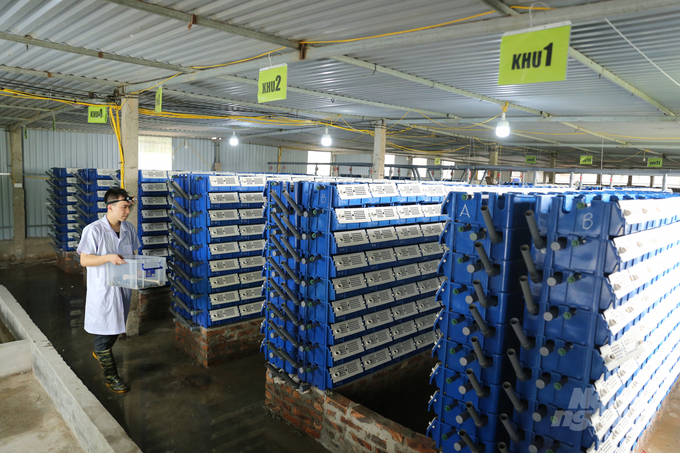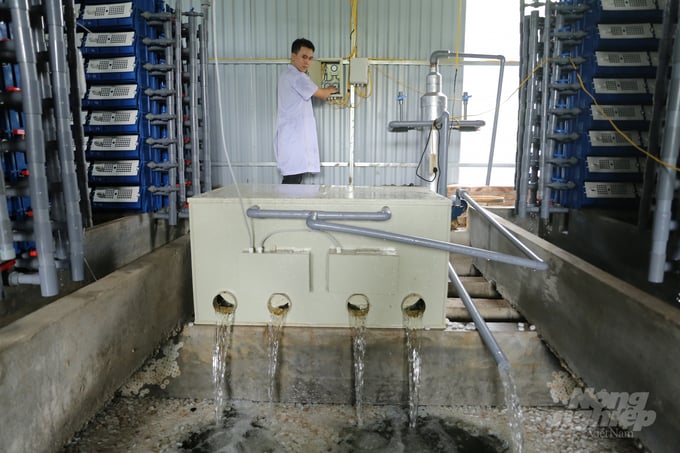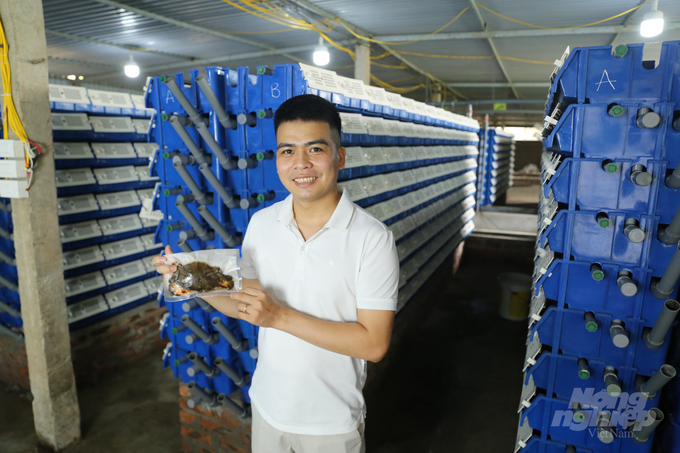Recently, newspaper Vietnamese culture There was an article by Ms. Nguyen Thi Kim Oanh in Village 3, Van Phuc Township (Thanh Tri District) appreciating the unique model of successful rearing of sea crabs in plastic containers in Hanoi. In addition to Ms. Oanh’s model, there is another very successful sea crab farm in Hanoi owned by Mr. Nguyen Vu in Tien Le Village, Tien Yen Township, Hoai Duc District. When we visited Mr. Vu’s sea crab farm, we were surprised to learn that this farmhouse model with an area of just over 400m2 brings in hundreds of millions of VND in revenue per month.
Start a business by going to a restaurant
Nguyen Vu, the owner of the farm, was born in 1994, originally from Soc Son (Hanoi). Discussing the idea of starting a farm, Vu said he was simply a stock investor in the past. Once he happened to go to a restaurant to enjoy sea crab, saw yellow crab bricks, greasy, not sick, crab meat firm, delicious … more than usual, curious to know that the restaurant … gave the wrong answer. Court !
“Crab shell is very soft, edible, full of meat, very tasty, full of nutrients. Ask the restaurant staff why there is such a strange crab, they say: “You are lucky, people ordered the wrong one. The price of shrimp nuggets is always twice as expensive as shrimp with regular meat.” That’s how I got the idea to learn about shrimp with nuggets to raise,” Nguyen confided to Vu.

Plastic boxes are arranged in a truss, numbered, each box has only one crab so they don’t eat each other. Picture: Dieu Wy.
After that, Vu went to the ponds to raise crabs in Quang Ninh, Thai Binh, Nam Dinh provinces… to find out. Experienced farmers said that it is not possible to harvest crayfish at the same time as they are moulting, since each crayfish changes its shell on a different day, when the old one is replaced, the new shell hardens after only 4 hours. .
In particular, tank crabs raised in the lagoon cannot find and select individual shelled crabs to harvest, so they often have to harvest all the waste, the lagoon owner sells them to traders for VND 280,000/kg of live crabs. If traders buy it and see nuggets (peeling) stage fish, then they filter it and sell it for 800,000-1,000,000 VND/kg, while regular crabs are sold for 400,000-500,000 VND/kg in the market.
When Vu heard that the Research Institute of Aquaculture III (Nha Trang, Khanh Hoa) is researching and experimenting with shrimp nuggets, Vu has come back to learn from experience. According to researchers at the institute, people in China and Thailand have been raising and selling crabs with nuggets for about a decade.
Realizing the economic potential of this unique crab, Vu decided to invest in 6,000 special plastic boxes for crab farming. The piping for operating the seawater for the shrimp farming is very complex to install on each cage box. Water from the shrimp farming boxes flows continuously through the pipes leading to the filtration system, including a microbiological filter tank for waste treatment.
The filtered water is recovered for the pump to return to the water line to the shrimp hatchery boxes. The key to this system is the Kaldnes grains (like coral) which are a breeding ground for microorganisms and treat crab waste to make the environment cleaner. After that, the water is treated with a UV lamp (treatment of algae and bacteria, fungi, etc.), which acts like sunlight, imitating nature.
The crabs were fed twice a day mainly green mussels, sea buckthorn and snails. The skin crab eats oysters with the shell, which contains a lot of calcium to help the process of forming a new shell. The quality of crab meat does not depend on its range of movement, but on the nutritional composition of the food. The average feed cost for each crab is about 1,000 VND/day.
Big investment, meticulous engineering
When trying a new model for the first time, difficulties are inevitable. Vu shared: “Water is the key factor in the success or failure of sea crab farming in plastic containers. Every 50 m3 of seawater used for crab farming is imported to Hanoi from Ha Long (Quang Ninh) at a price of VND 500,000/m3. The loss is about 10% per month, which can be replenished with fresh water.”

Technicians regularly check the water system because the water environment must always meet the standards for the crabs to grow well. Picture: Dieu Wy.
“The filter runs continuously day and night, usually every 4 hours, the machine is idle for about 15 minutes. The water used to raise sea crabs is tested regularly, at least three times a day, to check the pH and salinity to ensure the best environment for the crabs to grow,” noted the crab farm owner.
The above experiences stem from the failure of the early days of starting a business. At that time, Vu invested about 10 million VND each time, but after only 7-10 days of breeding, 98% of the crabs died. Each time he failed, Vu checked the water source, asked biologists for advice on the right index for crabs and how to act effectively when the index exceeds the allowable threshold…
In order to have a favorable agricultural business location, Nguyen Vu decided to rent more than 400 m2 of land from a farmer in the middle of a clean vegetable growing area in Tien Yen commune (Hoai Duc district, Hanoi) for VND15 million/month. . The total investment cost of building and installing the model of 6,000 shrimp breeding boxes is about VND 2 billion. “In the beginning it was very confusing because the investment capital was large. The entire farm with 6,000 farming boxes and an investment threshold of VND 2 billion is expected to recover capital in 2 years. If this fails, it will be difficult to change the model,” Nguyen confided in Vu.

Currently, due to the limited number of farmers, Mr. Vu’s facility is not supplying enough products compared to the demand for orders from partners, so the model will be replicated for many other farming households. Picture: Dieu Wy.
Then, thanks to careful study of water purification techniques and investment “dose”, Vu succeeded in the third test. Filtering seawater to raise crabs in plastic tanks is different from the traditional model – farming in the lagoon. Rather than simply pouring food into the lagoon, the nurturing process of raising crabs in a plastic box requires more care and more stages. Every day, farmers must open each box to feed and clean up the crabs, as well as “diagnose” the time to prepare the crab’s shell. However, this is also an advantage to take advantage of high-quality crab lines that conventional models cannot.
“If you’re using a flashlight, crabs that have gone out of light all morning and are showing signs of cracking means they’re about to enter the molting phase. These animals are placed in boxes with the same divisions so that they can be easily tracked,” the farm owner reveals more secrets.
Unique products, open market
Up to now, Nguyen Vu’s model of raising sea crabs in plastic boxes has been running stably for about 3 months, selling 300-400 kg of nuggets and shell crabs every month, earning about VND 250-300 million, with an average selling price of about 700-800,000 VND/kg, even more than 1,000,000 VND/kg if the crabs are big and have a nice design.
The farm owner estimates that with the initial import capital of about 300-400,000 VND/kg of small crabs (from 1.8 to 4 grams/head), after 25 days to 1 month, a profit of about 150-400,000 VND is possible 180,000 VND/kg . Hundreds of millions of dongs can be earned every month if enough goods are sold.
According to Mr Vu, sea crab is currently being consumed in supermarket systems such as EcoFoods and upscale restaurants through acquaintances or through online advertising. At the time of building the model, the farm had to spend about 50 million VND per month, so customers knew that once they had stable goods, it didn’t take much effort to offer them.

The owner of Nguyen Vu crab farm is satisfied with the finished product made from peeled crabs (which have been frozen). Picture: Dieu Wy.
Mr. Chu Huy Hoang, chairman of EcoFoods clean food supermarket chain, highly appreciated the products of Nguyen Vu Farm’s shrimp nuggets and shelled shrimp: “In addition to the high nutritional value, the flesh is firm and does not need to be thrown away, while the flesh shrimp almost loses half their weight as a shell. Sea crabs are easy to buy directly in Hanoi without having to transport far.
Commenting that the current crab farming market is still small and fragmented, and people in particular still depend on traders, Nguyen Vu and his collaborators are striving for a cooperative ecosystem model. In particular, people who want to learn how to invest in a model of sea crab farming in plastic boxes can get technical support and advice on local input and output products in the most effective way.
“Families raised in the Lagoon sell at low prices and waste resources. 1m2 of land can only raise 2 crabs according to the technique, while 2.8m2 can raise up to 252 crabs,” analyzed Vu, emphasizing that this new model is very suitable for replication because it can both develop and grow in the city that both help people increase their income and create a nutritious product.As the model grows, the price will also decrease, benefiting both farmers and consumers.
The owner of the crab farm shared that since each crab is raised in a box, it’s easy to check the growth process and change the shell. Every day, staff inspect each crab, see which one has peeled the apricot shell, then harvest them, vacuum bag them, freeze them and ship them to grocery stores and supermarkets.

